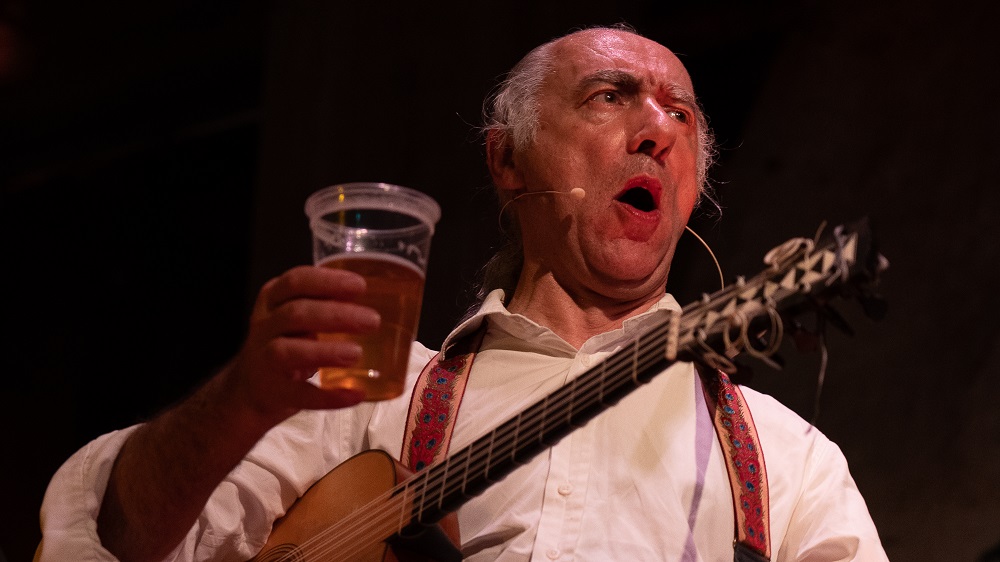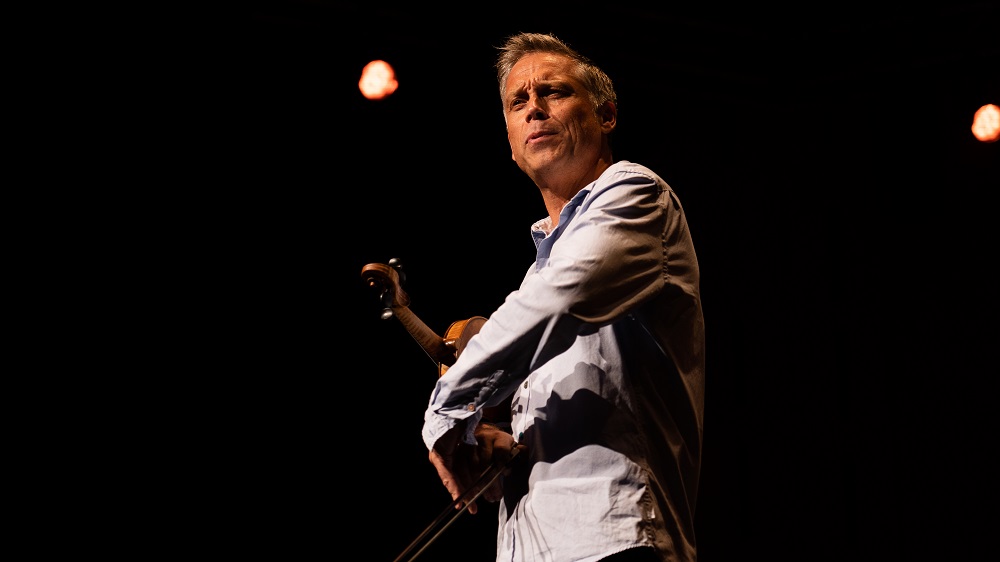Purcell's Playhouse, Bevan, Barokksolistene, Eike, Purcell Room review - kaleidoscopic delights | reviews, news & interviews
Purcell's Playhouse, Bevan, Barokksolistene, Eike, Purcell Room review - kaleidoscopic delights
Purcell's Playhouse, Bevan, Barokksolistene, Eike, Purcell Room review - kaleidoscopic delights
Vivacious British soprano shares the communicative spirit of her Norwegian colleagues

“What about the communication with the audience?” asked violinist and impresario Bjarte Eike in his First Person piece for theartsdesk. “How can a 'normal' concert be turned into a special event?” Explaining how is one thing – but doing it to dazzle our senses is what counts. Though the Alehouse Session which followed out in the foyer was brilliant business more or less as usual, “Purcell’s Playhouse” took us further on the road of making the old absolutely new.
The cue for our entertainment surely came from great Henry himself, purveyor of theatre music for curious hybrids as well as odes and instrumental masterpieces, but only one work we’d strictly call an opera. Dido and Aeneas. To the Overture from The Old Batchelor, our players strutted on and promenaded – even cellist Judith-Maria Blomsterberg, whose instrument never touched the ground. Hail, too, or welcome back, to consummate jack-of-all-trades Steven Player (pictured below at the later Alehouse Session), whose superb movements incorporate flamenco and Irish dancing (but the arms fly while body and head are kept still).  For some reason the South Bank hadn’t supplied the proffered programme details, which simply meant that Eike had to work harder – which with him always seems charming and effortless – on telling us what we’d heard or were going to hear (pictured below). Spotlight next on the very special guest, Mary Bevan. It was already good to see Blomsterberg and Naomi Burell among the players; the Alehouse sessions proper tend to be very blokey affairs. And now we had a performer fully in tune with the communicative spirit of the team.
For some reason the South Bank hadn’t supplied the proffered programme details, which simply meant that Eike had to work harder – which with him always seems charming and effortless – on telling us what we’d heard or were going to hear (pictured below). Spotlight next on the very special guest, Mary Bevan. It was already good to see Blomsterberg and Naomi Burell among the players; the Alehouse sessions proper tend to be very blokey affairs. And now we had a performer fully in tune with the communicative spirit of the team.
The big solo scena, Bevan in partnership with harpsichordist Hans Knut Sveen, was the very dramatic, freewheeling character-study “Mad Bess”, complete with scene-setting where the soprano quickly won her laurels ad-libbing to a clatter from below stage right. Then she integrated perfectly with the big sequence at the heart of the programme – no less than 10 Purcell pieces of all shapes, and speeds, the element of improvisation and Helge Andreas Norbakken’s percussion fitting perfectly into the context. As there were a fair number of chaconnes, where a line constantly repeats with various ideas above it, it was absolutely natural for double-bass Johannes Lundberg to inject what felt like a laid-back jazz vibe.  Just once, with the pack rounding as malign fairies and hobgoblins on the soprano, the theatricality verged on the overdone, but mostly it was a delight. For the Fantasia a4, Eike and viola-player Per Buhre (adaptable as counter-tenor) came from the back of the hall to join their two colleagues on stage – a magical effect. Likewise Bevan’s exquisite poise in An Evening Hymn, ending in a sleep stalked by another singer and Alehouse regular, Thomas Guthrie, in “Hush no more” from The Fairy Queen. Magical chorus – these instrumentalists do vocals to perfection, too – then exeunt omnes, fingers to lips.
Just once, with the pack rounding as malign fairies and hobgoblins on the soprano, the theatricality verged on the overdone, but mostly it was a delight. For the Fantasia a4, Eike and viola-player Per Buhre (adaptable as counter-tenor) came from the back of the hall to join their two colleagues on stage – a magical effect. Likewise Bevan’s exquisite poise in An Evening Hymn, ending in a sleep stalked by another singer and Alehouse regular, Thomas Guthrie, in “Hush no more” from The Fairy Queen. Magical chorus – these instrumentalists do vocals to perfection, too – then exeunt omnes, fingers to lips.
There had to be a rollicking encore, though, and Eike told us they’d knocked this one together the night before. The Sailors and Witches in Dido are usually something of an irritant, so why not go way over the top for laughs? They did, and the audience loved it. Then to the Alehouse in the foyer, and familiar, always welcome business from the blokes. The one thing I don’t go happily along with is Guthrie’s slightly uneasy style – the talent doesn't seem to me quite equal to the rest – so when he started up his sea shanty shtick past 11pm, it was time to make a discreet exit. This is probably the only time when I’d say that the Alehouse felt like an optional extra, Purcell’s Playhouse having served up such a perfect banquet. But for those experiencing the unique formula for the first time, it would have been just as welcome.
rating
Explore topics
Share this article
The future of Arts Journalism
You can stop theartsdesk.com closing!
We urgently need financing to survive. Our fundraising drive has thus far raised £49,000 but we need to reach £100,000 or we will be forced to close. Please contribute here: https://gofund.me/c3f6033d
And if you can forward this information to anyone who might assist, we’d be grateful.

Subscribe to theartsdesk.com
Thank you for continuing to read our work on theartsdesk.com. For unlimited access to every article in its entirety, including our archive of more than 15,000 pieces, we're asking for £5 per month or £40 per year. We feel it's a very good deal, and hope you do too.
To take a subscription now simply click here.
And if you're looking for that extra gift for a friend or family member, why not treat them to a theartsdesk.com gift subscription?
more Classical music
 First Person: Manchester Camerata's Head of Artistic Planning Clara Marshall Cawley on questioning the status quo
Five days of free events with all sorts of audiences around Manchester starts tomorrow
First Person: Manchester Camerata's Head of Artistic Planning Clara Marshall Cawley on questioning the status quo
Five days of free events with all sorts of audiences around Manchester starts tomorrow
 Goldscheider, Brother Tree Sound, Kings Place review - music of hope from a young composer
Unusual combination of horn, strings and electronics makes for some intriguing listening
Goldscheider, Brother Tree Sound, Kings Place review - music of hope from a young composer
Unusual combination of horn, strings and electronics makes for some intriguing listening
 theartsdesk Q&A: composer Donghoon Shin on his new concerto for pianist Seong-Jin Cho
Classical music makes its debut at London's K-Music Festival
theartsdesk Q&A: composer Donghoon Shin on his new concerto for pianist Seong-Jin Cho
Classical music makes its debut at London's K-Music Festival
 Helleur-Simcock, Hallé, Wong, Bridgewater Hall, Manchester review - moving lyricism in Elgar’s concerto
Season opener brings lyrical beauty, crisp confidence and a proper Romantic wallow
Helleur-Simcock, Hallé, Wong, Bridgewater Hall, Manchester review - moving lyricism in Elgar’s concerto
Season opener brings lyrical beauty, crisp confidence and a proper Romantic wallow
 Kohout, Spence, Braun, Manchester Camerata, Huth, RNCM, Manchester review - joy, insight, imagination and unanimity
Celebration of the past with stars of the future at the Royal Northern College
Kohout, Spence, Braun, Manchester Camerata, Huth, RNCM, Manchester review - joy, insight, imagination and unanimity
Celebration of the past with stars of the future at the Royal Northern College
 Jansen, LSO, Pappano, Barbican review - profound and bracing emotional workouts
Great soloist, conductor and orchestra take Britten and Shostakovich to the edge
Jansen, LSO, Pappano, Barbican review - profound and bracing emotional workouts
Great soloist, conductor and orchestra take Britten and Shostakovich to the edge
 Jakub Hrůša and Friends in Concert, Royal Opera review - fleshcreep in two uneven halves
Bartók kept short, and a sprawling Dvořák choral ballad done as well as it could be
Jakub Hrůša and Friends in Concert, Royal Opera review - fleshcreep in two uneven halves
Bartók kept short, and a sprawling Dvořák choral ballad done as well as it could be
 Hadelich, BBC Philharmonic, Storgårds, Bridgewater Hall, Manchester review - youth, fate and pain
Prokofiev in the hands of a fine violinist has surely never sounded better
Hadelich, BBC Philharmonic, Storgårds, Bridgewater Hall, Manchester review - youth, fate and pain
Prokofiev in the hands of a fine violinist has surely never sounded better
 Monteverdi Choir, ORR, Heras-Casado, St Martin-in-the-Fields review - flames of joy and sorrow
First-rate soloists, choir and orchestra unite in a blazing Mozart Requiem
Monteverdi Choir, ORR, Heras-Casado, St Martin-in-the-Fields review - flames of joy and sorrow
First-rate soloists, choir and orchestra unite in a blazing Mozart Requiem
 Cho, LSO, Pappano, Barbican review - finely-focused stormy weather
Chameleonic Seong-Jin Cho is a match for the fine-tuning of the LSO’s Chief Conductor
Cho, LSO, Pappano, Barbican review - finely-focused stormy weather
Chameleonic Seong-Jin Cho is a match for the fine-tuning of the LSO’s Chief Conductor
 Classical CDs: Shrouds, silhouettes and superstition
Cello concertos, choral collections and a stunning tribute to a contemporary giant
Classical CDs: Shrouds, silhouettes and superstition
Cello concertos, choral collections and a stunning tribute to a contemporary giant
 Appl, Levickis, Wigmore Hall review - fun to the fore in cabaret and show songs
A relaxed evening of light-hearted fare, with the accordion offering unusual colours
Appl, Levickis, Wigmore Hall review - fun to the fore in cabaret and show songs
A relaxed evening of light-hearted fare, with the accordion offering unusual colours

Add comment